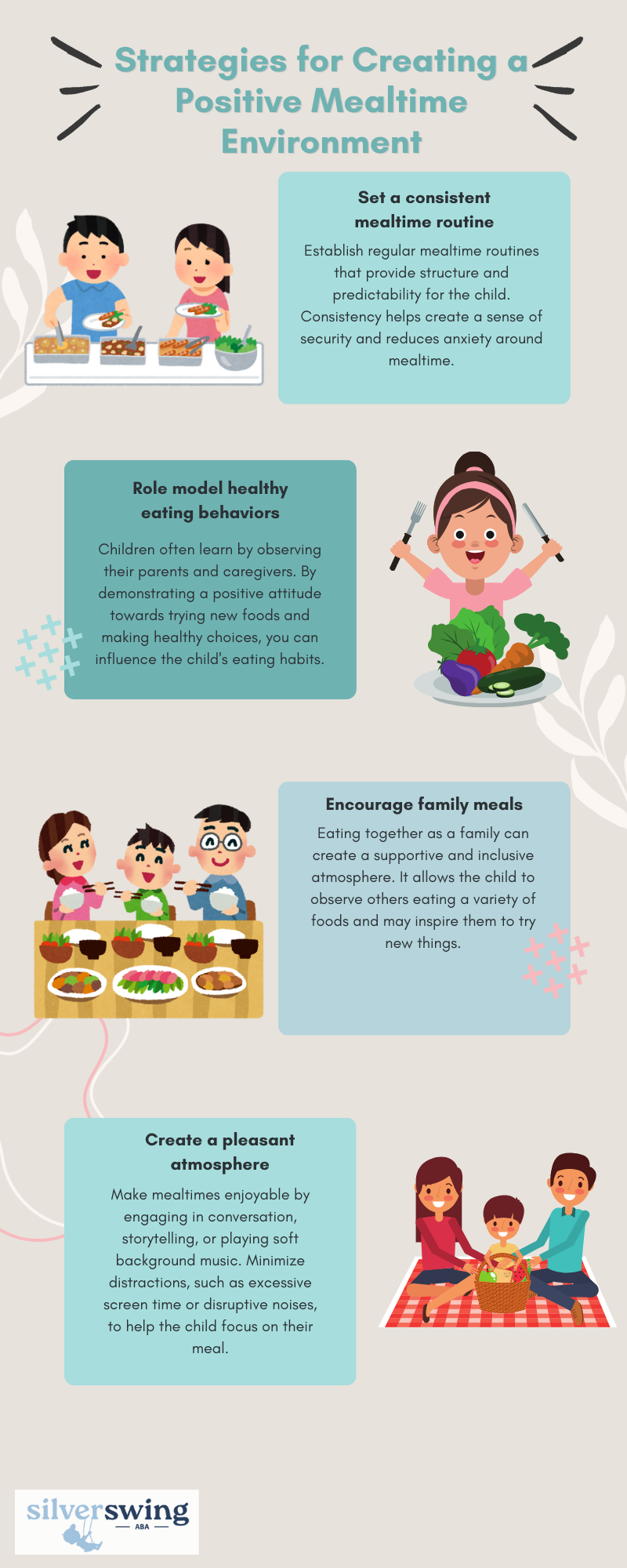Picky eating is a common challenge faced by many children with autism. In fact, a lot of children with autism exhibit some form of food selectivity, leading to a diet that includes fewer dairy products, fruits, vegetables, and whole grains compared to typical children.
These selective eating habits can be attributed to sensory sensitivities, texture aversions, and rigid eating patterns commonly associated with autism.

Impact of Picky Eating on Autistic Children
Picky eating can have significant implications for children with autism. Limited food choices can result in inadequate nutrition, affecting their overall health and well-being. Eating a variety of foods, especially fruits and vegetables, is crucial for children with autism as it supports growth and development, and it also helps prevent chronic diseases like heart disease and diabetes.
Moreover, picky eating can also impact social interactions and family dynamics. It may limit opportunities for shared meals and hinder the development of positive eating habits.
Children with autism often do not outgrow picky eating habits without formal intervention, unlike most typically developing children who tend to outgrow picky eating by age 7 with exposure to new foods.
To address the challenges associated with picky eating in autism, it is important to implement strategies that encourage a diverse and balanced diet. By understanding the prevalence and impact of picky eating, parents and caregivers can take proactive steps to support their children in developing a healthy relationship with food and expand their food preferences.

How to Address Picky Eating
In order to address picky eating in children with autism, it’s important to implement effective strategies that can help expand their food preferences and ensure they receive proper nutrition.
Let’s have a look at what these strategies are.
Introducing New Foods
Introducing new foods to children with autism requires patience, understanding, and a gradual approach. It’s important not to pressure the child to eat or force them to try new foods, as this can create negative associations and further reinforce their picky eating behaviors.
Instead, consider the following tips:
- Start with small, incremental steps – Begin by introducing small portions of new foods alongside familiar foods. This allows the child to explore new flavors and textures at their own pace.
- Use visual aids – Visual supports, such as picture cards or food charts, can help children with autism understand and engage with new foods. Visual representations can make the concept of trying new foods more concrete and less overwhelming.
- Incorporate familiarity – Pair new foods with familiar foods that the child enjoys. This can help create positive associations and increase the likelihood of acceptance.
- Allow for sensory exploration – Encourage the child to touch, smell, and interact with new foods without the pressure to consume them. This sensory exploration can help desensitize them to new textures and increase their comfort levels.
Remember, introducing new foods to picky eaters with autism may require time, repetition, and patience. It’s essential to celebrate small victories and acknowledge progress, even if it is just a willingness to touch or smell the new food.
Family Meal Dynamics
Family mealtime can play a significant role in overcoming picky eating challenges for children with autism. Creating a positive mealtime environment and establishing healthy eating habits as a family can contribute to the overall success of addressing picky eating.
Make sure to consider the following strategies:

Building Healthy Food Relationships
Encouraging children with autism to develop a positive relationship with food is crucial for their long-term nutritional well-being. Here are some strategies to help build healthy food relationships:
- Create a supportive and positive mealtime environment – Establish a calm and pleasant atmosphere during meals, free from distractions. Encourage open communication and make mealtime an enjoyable experience for the whole family.
- Offer a variety of foods – Introduce a wide range of foods, including fruits, vegetables, whole grains, and proteins. Encourage children to explore different flavors, textures, and colors. Gradually expand their food preferences by incorporating new options into familiar meals.
- Involve children in meal planning and preparation – Allow children to participate in selecting groceries and preparing meals. This can help them develop a sense of ownership and curiosity about food, making them more likely to try new things.
- Be a role model – Children often mimic the behaviors and attitudes of their parents and caregivers. Demonstrating a positive attitude towards healthy eating and trying new foods can influence their food choices and preferences.
Consulting with Healthcare Providers
One of the first steps for parents and caregivers of children with autism who are dealing with picky eating is to consult with healthcare providers. Pediatricians and specialists familiar with autism can provide valuable insights and guidance tailored to the specific needs of the child.
Healthcare providers can assess the child’s overall health and nutritional status, identify any deficiencies or imbalances, and offer appropriate recommendations. They can also address doubts or concerns about creating an autism diet menu and provide advice on how to ensure the child receives a balanced and nutritious diet.
Working closely with healthcare providers allows for a collaborative approach to developing strategies to address picky eating. They can help create personalized plans that consider the child’s specific preferences, sensory sensitivities, and nutritional requirements.
Using Dietary Supplements
In some cases, dietary supplements may be recommended to complement the child’s diet and address potential nutrient gaps. Dietary supplements can provide additional vitamins, minerals, or other essential nutrients that may be lacking in a limited diet.
Before incorporating dietary supplements, it is important to consult with a healthcare provider, such as a pediatrician. They can evaluate the child’s specific nutritional needs and recommend appropriate supplements, taking into account any potential interactions or contraindications.
It’s important to note that dietary supplements should not replace a varied and balanced diet.
They should be used as a supplement to support the child’s nutritional intake and should be part of an overall plan developed in consultation with healthcare professionals.
Monitoring Progress and Adjusting Strategies
Monitoring progress is crucial in assessing the effectiveness of strategies used to address picky eating in children with autism. Here are some tips for monitoring progress and adjusting strategies:
- Keep a food diary – Maintain a record of the foods your child eats, including their reactions and preferences. This can help identify patterns, track progress, and identify areas that may require further attention.
- Consult with professionals – Collaborate with healthcare providers, including pediatricians, registered dietitians, and behavior analysts. They can provide guidance, monitor nutritional needs, and offer specialized support to address feeding issues.
- Evaluate and adjust strategies – Regularly assess the effectiveness of the strategies being implemented. If certain approaches are not yielding the desired results, consider modifying them or trying alternative techniques. Flexibility and adaptability are key in finding what works best for your child.
By adopting a long-term approach to nutrition, parents and caregivers can help children with autism develop a healthier relationship with food.
Building positive food relationships and monitoring progress while adjusting strategies can pave the way for improved eating habits, expanded food preferences, and overall better nutritional outcomes.

Tips for Parents and Caregivers
Parents and caregivers also play a crucial role in addressing picky eating in children with autism. By implementing the following tips, they can create a supportive environment that promotes healthier eating habits:
- Avoid pressuring the child to eat – Pressuring or forcing a child to eat can create additional stress and resistance. Instead, focus on creating a positive and relaxed mealtime environment.
- Enjoy meals together as a family – Eating together as a family can positively influence a child’s eating habits. Modeling healthy eating behaviors and providing a variety of foods can encourage the child to try new things.
- Utilize time, repetition, and familiarity – Introducing new foods may require patience. Gradually expose the child to new foods over time, offering them repeatedly and in different ways to increase familiarity and acceptance.
- Allow hunger to motivate eating – Avoid constant snacking or offering preferred foods immediately before meals. Allowing the child to experience hunger before a meal can increase their motivation to try new foods.
- Consider dietary supplements – Some children with autism may have nutrient deficiencies due to limited food choices. Consult with a pediatrician or trusted professional about the use of dietary supplements designed for autistic children to address these deficiencies.
Parents and caregivers should remember that every child is unique, and it may take time to see progress. Consistency, patience, and a supportive approach are key when implementing strategies to address picky eating in children with autism.
By implementing these tips, parents and caregivers can create a positive feeding environment that promotes healthier eating habits and expands the range of foods their child is willing to try.




